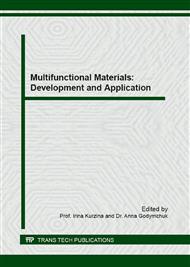[1]
V.G. Nikolaev, V.A. Samsonov, Analysis of medical use of carbon adsorbents in China and additional possibilities in this field achieved in Ukraine, Artificial Cells, Nanomed. and Biotech. 42 (2014) 1–5.
DOI: 10.3109/21691401.2013.856017
Google Scholar
[2]
I.M. Smolyakova, V.Y. Andreeva, G.I. Kalinkina, S.N. Avdeenko, P.P. Shchetinin, Development of extraction techniques and standardization methods for a common lady's mantle (Alchemilla vulgaris) extract, Pharm. Chem. J. 45 (2012) 675–678.
DOI: 10.1007/s11094-012-0702-7
Google Scholar
[3]
V.O. Njokua, M.A. Islama, M. Asif, B.H. Hameed, Utilization of sky fruit husk agricultural waste to produce high quality activated carbon for the herbicide bentazon adsorption, Chem. Eng. J. 251 (2014) 183–191.
DOI: 10.1016/j.cej.2014.04.015
Google Scholar
[4]
N.I. Ursova, The role of enterosorbents in treatment of endogenous intoxication syndrome, Curr. Pediatr. [Voprosy sovremennoy pediatrii – in Russian]. 11 (2012) 26–31.
DOI: 10.15690/vsp.v11i6.489
Google Scholar
[5]
V.K. Guptaa, B. Guptaa, A. Rastogic, S. Agarwald, A. Nayak, A comparative investigation on adsorption performances of mesoporous activated carbon prepared from waste rubber tire and activated carbon for a hazardous azo dye – Acid Blue 113, J. Hazard. Mater. 186 (2011).
DOI: 10.1016/j.jhazmat.2010.11.091
Google Scholar
[6]
A.M.M. Vargas, A.L. Cazetta, M.H. Kunita, T.L. Silva, V.C. Almeida, Adsorption of methylene blue on activated carbon produced from flamboyant pods (Delonix regia): Study of adsorption isotherms and kinetic models, Chem. Eng. J. 168 (2011) 722–730.
DOI: 10.1016/j.cej.2011.01.067
Google Scholar
[7]
Y. Lia, Q. Dua, T. Liua, X. Pengb, J. Wanga, J. Suna, Y. Wanga, S. Wua, Z. Wanga, Y. Xiaa, L. Xiaa, Comparative study of methylene blue dye adsorption onto activated carbon, graphene oxide, and carbon nanotubes, Chem. Eng. Res. Des. 91 (2013).
Google Scholar
[8]
D.A. Markelov, O.V. Nitsak, I.I. Garashchenko, Comparative study of the adsorption activity of medicinal sorbents, Pharm. Chem. J. 42 (2008) 405–408.
DOI: 10.1007/s11094-008-0138-2
Google Scholar
[9]
D.V. Onishchenko, V.P. Reva, B.A. Voronov, Adsorption activity of carbon nanotubes formed from brown sphagnum moss in mechanical activation, J. Anal. Chem+. 69 (2014) 403–407.
DOI: 10.1134/s1061934814050074
Google Scholar
[10]
N.V. Garyntseva, I.G. Sudakova, B.N. Kuznetsov, Properties of Enterosorbents Obtained from Acetic Acid Lignins of Abies, Aspen and Birch Wood, Journal of Siberian Federal University. Chemistry [Zhurnal sibirskogo federal'nogo universiteta. Himija – in Russian]. 4 (2011).
Google Scholar
[11]
I.A. Muraviev, Yu.G. Pshukov, Theoretical foundations of the method of production of liquid extracts repercolation with complete cycle: guidelines, Pyatigorsk [in Russian], (1985).
Google Scholar
[12]
E. Ekramia, F. Dadashiana, M. Arami, Adsorption of methylene blue by waste cotton activated carbon: equilibrium, kinetics, and thermodynamic studies, Des. Water Treat. (2015) DOI: 10. 1080/19443994. 2015. 1015173.
DOI: 10.1080/19443994.2015.1015173
Google Scholar
[13]
A.F. Hassana, A.M. Abdel-Mohsen, M.M.G. Fouda, Comparative study of calcium alginate, activated carbon, and their composite beads on methylene blue adsorption, Carbohyd. Polym. 102 (2014) 192–198.
DOI: 10.1016/j.carbpol.2013.10.104
Google Scholar


